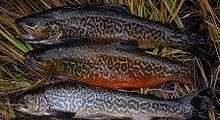Tiger trout
| Tiger trout | |
|---|---|
 | |
| Scientific classification | |
| Kingdom: | Animalia |
| Phylum: | Chordata |
| Class: | Actinopterygii |
| Order: | Salmoniformes |
| Family: | Salmonidae |
| Subfamily: | Salmoninae |
| Binomial name | |
| Salmo trutta × Salvelinus fontinalis | |
The tiger trout (Salmo trutta × Salvelinus fontinalis) is a sterile, intergeneric hybrid of the brown trout (Salmo trutta) and the brook trout (Salvelinus fontinalis). The name derives from the pronounced vermiculations, evoking the stripes of a tiger. It is an anomaly in the wild, with the brook trout having 84 chromosomes and the brown trout 80.[1][2] Records show instances as far back as 1944.[3] The cross itself is unusual in that the parents are members of different genera.[4]
Artificial production
Tiger trout can be produced reliably in hatcheries. This is done by fertilizing brown trout eggs with brook trout milt and heat shocking, causing the creation of an extra set of chromosomes and increasing survival rates from 5% to 85%.[5] Tiger trout have been reported to grow faster than natural species,[6] though this assessment is not universal,[7] and they have been widely stocked for sport fishing.
Tiger trout are known to be highly piscivorous (fish-eating), and are a good control against rough fish populations. This makes tigers popular with many fish stocking programs, such as with the Utah Division of Wildlife Resources.[8] Their own population numbers can be tightly controlled as well, since they are sterile.
Many US states have had stocking programs for tiger trout. Wisconsin discontinued its program in the late 1970s. Tigers were exclusively stocked in the Great Lakes. After the stocking program was discontinued, a 20-pound-plus (9-kg-plus) world-record tiger trout was caught in the Great Lakes.
Hybridization experiments with salmonids were carried out with several world known sperm activating mediums for artificial insemination of eggs from freshwater fishes. In Bulgarian fish farms, experiments were carried to study the viability, performance traits and the fertility of hybrids.[9] It was achieved 100% fertilizing brook trout - Salvelinus fontinalis М. eggs with semen from brown trout - Salmo trutta m. fario L. using of medium 49282 - single or along with extender 49283, but embryonic mortality was 100%. The ultimate variant /♂ Salvelinus fontinalis М. Х ♀ Salmo trutta m. fario L./ was successful for optimize crossbreeding. Medium 49282 have the best sperm activating effect and may use along with extender 49283 for artificial insemination to produce tiger trout. Obtained fry are more vital and energetic with faster grow and developing. It was made basic definition of produced trout hybrids – soft snout, low situated eyes and typicalness tiger color. The experiment is continuing, it is evident that more research is necessary before the potential value of obtained hybrids for fish farming can be properly assessed.
Wild tiger trout
Wisconsin currently has no stocking program for tiger trout, but the hybrids show up naturally in the state's small streams (in particular in the Driftless Area). As brook trout populations have rebounded, incidences of tiger trout have improved from "exceedingly rare" to a "a bit better than rare."[10]
Michigan tends to have a number of tiger trout in its streams, due to its high population of brook trout. Catching them consistently would not be possible.
See also
References
- ↑ Mark A. Nale When a Trout is a Tiger! Pennsylvania Council of Trout Unlimited. Retrieved 11 September 2006
- ↑ The Brown Trout Brook Trout hybrid aka Tiger trout - Brown Trout Facts about Spawning, Habitat & Fly Fishing Guide
- ↑ Salmo x Salvel hi inus trutta x fontinalis USGS Nonindigenous Aquatic Species database. Retrieved 11 September 2006
- ↑ Beautiful Bastards: Check Out These Tiger Trout Photos | Field & Stream
- ↑ Thousands of tigers released in Utah (trout that is!) Utah Division of Wildlife Resources, 24 May 2005. Retrieved 11 September 2006
- ↑ Watch out, Utah chubs: Tiger trout placed in Scofield Reservoir Utah Division of Wildlife Resources, 24 May 2005. Retrieved 11 September 2006
- ↑ Tiger Trout & Hybrids Pennsylvania Fish & Boat Commission. Retrieved 11 September 2006
- ↑ Tiger Trout Fishing - Utah Fish Species - Utah Fishing Info
- ↑
- ↑ Searock, Kevin (2013). Troutsmith: An Angler's Tales and Travels. University of Wisconsin Press. pp. 32–35. ISBN 9780299293734.